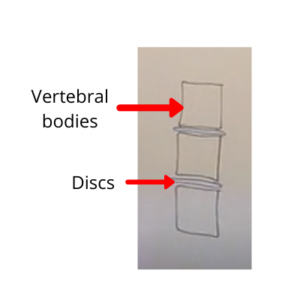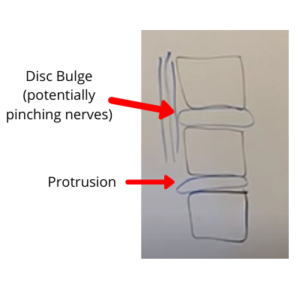Transcript
Hello, everybody. This is Dr. John Pitts of the Centeno-Schultz Clinic, where we are the leaders and inventors of much of the field of interventional orthopedics, which is basically treating and diagnosing musculoskeletal, orthopedic-type problems using injections and regenerative agents rather than using drugs and surgery.
Today, I’d like to talk about PRP for herniated disc. So, this is a pretty broad topic and we need to get some more details to get to what some of these terms mean.
What Is a Disc?
So when we talk about intervertebral discs, these are the cushions or shock absorbers that sit between the bones of your spinal canal, and they’re all along your spine. And, so, today, we’re talking about the lumbar, in particular.

What type of injuries or problems can occur with the disc?
So, you might see an MRI report or heard that you’ve got a degenerated disc, disc bulge, disc protrusion, disc herniation, collapsed disc, annular tear, HIT — what the heck does all that mean? So I’m just going to try to keep it really basic.

A protrusion would be like a bulge that’s just sticking off to one side versus the other. So, maybe it sticks more to the left, causing more problems to the left, or off to the right, et cetera.
Diffused or degenerative disc disease just means that the disc is getting dehydrated. The jelly is getting thinner. There’s less space between the discs. It may or may not be bulging. And so it’s kind of collapsed like this. And this can just happen with the wear and tear of aging. But when this happens, sometimes, it can cause pressure on the back, which would irritate joints in the back, called the facet joints. It can make the back unstable. It can cause spinal stenosis a decreased space between the back. That’s just the general “wear and tear” of degenerative disc disease.
Then there’s a disc herniation. Herniation specifically is when the inner jelly part of the disc starts to stick out, bulge into a weakness in the outer annulus fibers, and then it sticks out into the canal where the nerves run. It can cause irritation around those nerves and get some pinching or leak some chemical irritation around the nerves, which can cause pain down the legs or the Sciatic-type symptoms as well.
What can be done about these things?
So obviously the first step for many of these things is physical therapy.
When physical therapy isn’t working enough, most doctors will do a steroid-type injection, which can reduce inflammation around a nerve if a disc is herniated, a protrusion, protrusion protruding outwards on the nerve. And that may or may not help just temporarily for a few weeks just to allow you to do some more therapy. And, then, when that doesn’t help, they would tend to refer you to a surgeon to see if there’s anything that they can do.
But there’s a big step that most doctors miss in between physical therapy and surgery, and it can replace steroid injections, in fact. And that’s doing some type of PRP or Regenerative procedures for these problems.
OK, so “PRP,” again, we need to define. So PRP means platelet-rich plasma; that’s basically concentrating part of the blood, called platelets, that have a lot of growth factors that can stimulate repair. And there are many types of PRP. We’re going to talk about concentrated PRP that we just mentioned.
And also we can get the growth factors out of the platelets like a fast relief boost of growth factors. And we’ll call that “Platelet Lysate.” We are the first ones to start doing platelet lysate injections around nerves. That can actually replace steroid epidurals. We’ve seen in our research that helps improve pain and function better and for longer-lasting than steroid injections.
And then, we have to understand that most people just don’t have a disc problem, and that’s it. It’s going to effect, like I said, the joints, the ligaments, — all these other issues. So, we need to treat that whole spine as a functional unit and treat all those areas.
We really want to get the best results for a patient. And we’ve seen in our evidence that, when we do have a more thorough approach and not just treat the nerves — we also treat the joints and the ligaments, patients tend to do much better and for longer periods of time.
Can’t You Just Cure the Disc?
And then, specifically, for these disc problems, some people might be thinking: “Well, can you just put PRP in the disc and cure the disc?”
That’s a good question.
As for PRP for these disc problems, where and how you use it depends on the type of problem. So, for instance, if you have this disc bulge or disc protrusion, most of the time doing platelet lysate around the nerves, outside of the disc, and treating the ligaments, the joints, and the muscles around that area will help the most, in this case/scenario.
If there is some pain coming from a tear in a disc and that outer fiber, and it’s causing back pain, this may be causing the disc to protrude out and causing some leg pain; that’s another great scenario where we can use PRP specifically inside the disc.
Dr. Lutz of HHS has published quite a bit on this and has shown good results with doing PRP intradiscal. And so that can be very helpful in select patients, as well. Other times, we may just have this bulge without any nerve irritation. It’s just back pain caused by that disc. That’s another great indication to, maybe, go inside the disc, as well.
For these disc herniations, going into the disc is usually not a first step. Usually, you would stay at Platelet Lysate around the nerves, your body many times can absorb these herniations naturally without the need for surgery or to go on inside of the disc. So most of the time, just doing that Platelet Lysate, along with other structures, can help the body out in that way.
And then for degenerative disc disease, there’s really no indication to go inside the disc. There’s no cure that can replump these discs back up, or make the body back to 20 years old. But many people have this condition without any pain at all. And so we can treat, again, outside the nerves and into the joints and into the ligaments and try to support that structure to help reduce the load and reducing some of the pain and improving some of the function.
I know that was a pretty complicated review of just disc problems and how we can potentially treat them. But the key is that you understand that:
- There are different types of disc problems.
- Understand what those discs do. Acting as a shock absorber and as a cushion, they help with movement throughout the spine.
- And understand that there are many different types of treatments that we can do for this that can help avoid dangerous drugs like steroid injections, as well as big, dangerous surgeries that can cause more problems than they often solve, in the most part.
So the key is to find an expert that can actually give you these type of choices and options. Here at the Centeno-Schultz Clinic, it’s clear we are those experts. So, if you or anyone you know is dealing with back pain, degenerative disc problems, sciatic-type pain, please give us a call and see if we can help you out. You guys take care and have a great day.

